Propagation of begonias by cuttings at home
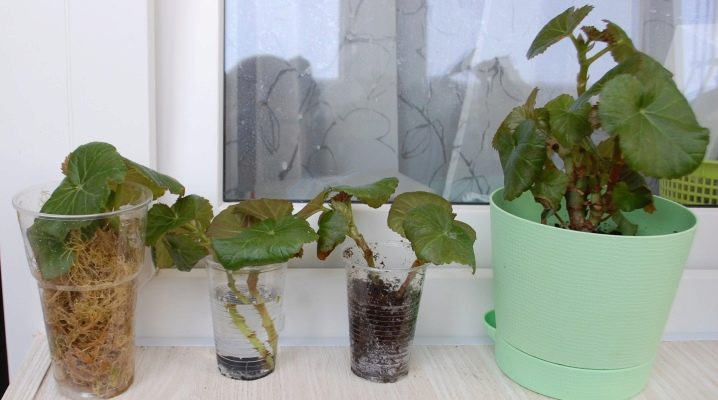
Begonia is a beautiful flower that you can buy and grow yourself at home. The plant can decorate houses, apartments, summer cottages, garden areas or parks. This flower is widespread in almost all countries of the world.
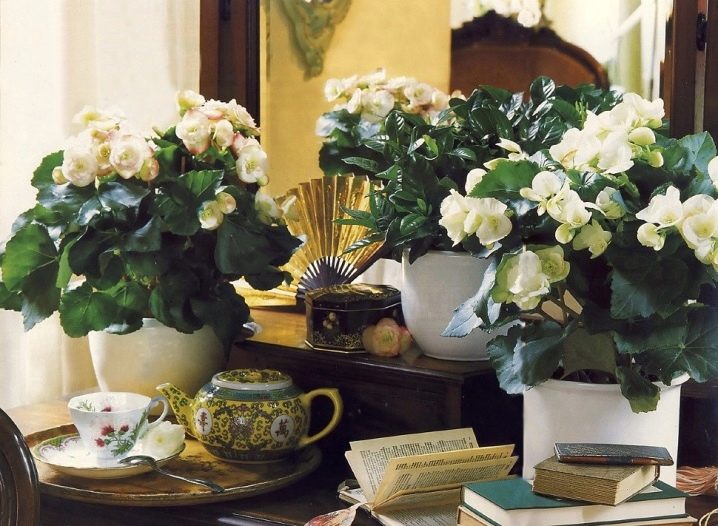
Peculiarities
Originally begonia from the rainforests of South America, Asia and Africa. The plant is rich in species diversity and has more than 900 species. There are deciduous, ornamental, reed, shrub and flowering species of this flower. Begonia has various shapes (drop-shaped, rounded, elongated), leaf colors (red, black-reddish, silver, with complex patterns, pinkish-green, purple, gray). The petals can be of the following colors: yellow, snow-white, cream, orange, red, pink and purple.
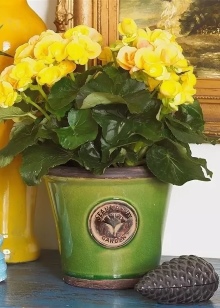
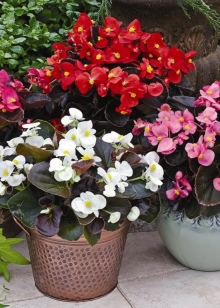
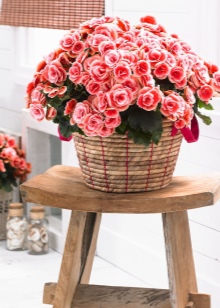
Preparation
Before planting the cuttings in the soil, you need to prepare them for reproduction and follow the step by step next steps.
- Using a sharp knife, cut off the top of the shoot, about 11 centimeters in length. There must be 2-3 nodes on the handle.
- It is necessary to remove the lower leaves and leave only 5-6 leaves on the top of the stem.
- Leave the cuttings to dry for a while. When the cut surface becomes dryish, you need to start rooting.
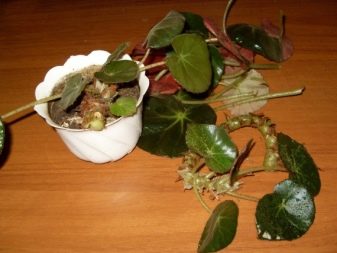
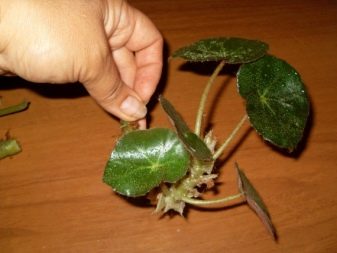
Landing
Growing begonia using cuttings is the fastest and most comfortable option for inexperienced growers and amateur gardeners. Cuttings are suitable for all stem begonias. If you need to transplant a flower, then it will be able to take root and grow well. With the help of cuttings, you can plant almost all types of this flower. In order for the cuttings to be good, you need to cut off part of the flower with a sharp knife. There is a variety of begonia called "Fista", it must be cut off. Each branch that will need to be planted should have 3 buds, and the branches should have a standard length of 11 centimeters.
If there are leaves on the cuttings, you do not need to cut them off. If the leaves are large, they need to be cut in half so that they cannot take a huge number of nutrients from the plant. Cuttings that have been cut off must be left to dry a little. To do this, you need to put them on a piece of paper and leave it for 120 minutes. It is better not to drop the cuttings directly into the container. It is better to leave the flower cuttings in liquid and place it in a bright room.
On some cuttings, the roots may appear on the fifth day, while in other varieties, the roots appear after a few weeks.
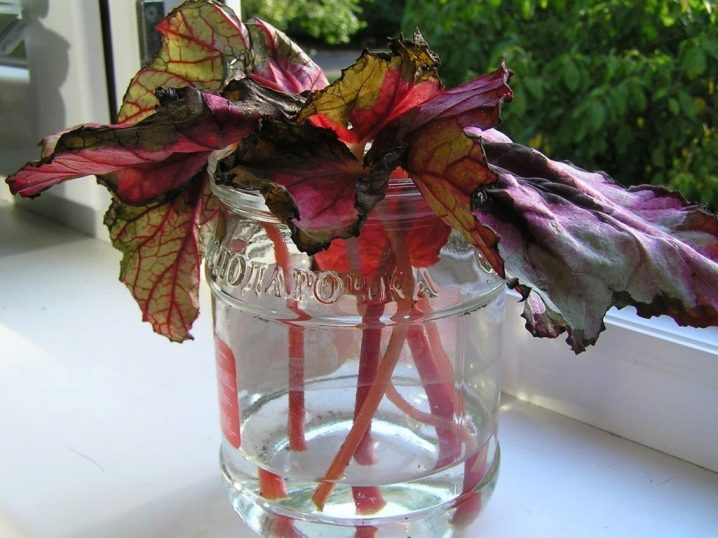
As soon as the first roots appear, you need to transplant the begonia into a good container, where there will be a drainage layer and correctly selected substrates. In special stores, you can buy soil that is designed for the development of this flower. On the advice of experts, you need to mix the acquired soil with sand. It is in such a soil that begonia can grow and develop well.
In order for a flower with a new root system to take root as soon as possible, it is necessary to process the sections with special solutions, such as "Kornevin" or "Heteroauxin". It is necessary to bury the cutting in a container at a depth of 1 centimeter from the roots. First, the plant will need moisture and heat, for this the begonia needs to be covered with half a plastic bottle, from which the bottom and lid have been cut off. With this method, the flower will grow well.As soon as the begonia gets stronger, you need to remove this shelter.
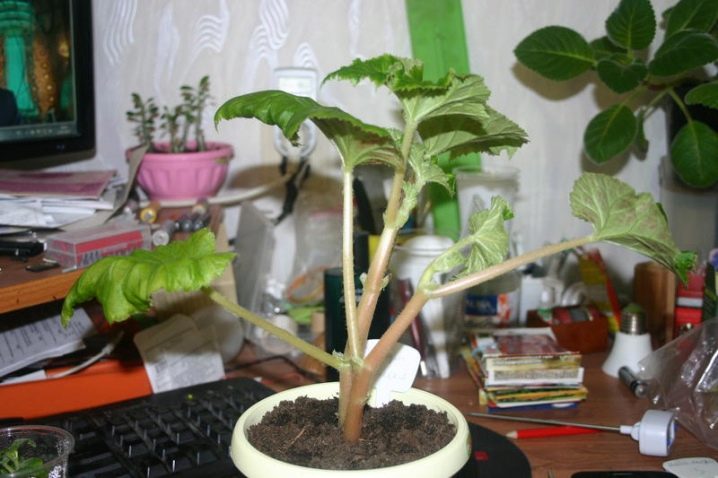
Rooting in water
If the plant cannot be propagated in the soil, or this method does not appeal to you, then the flower will be able to take root in the liquid. You just need to follow the next steps.
- To root a plant, you need to use a transparent container, pour a clean liquid at room temperature into it, put the cuttings there and wait. The liquid should contain only the stem without leaves.
- Cuttings soaked in liquid should be kept in a warm and light room. Care must be taken to ensure that the cuttings do not rot. You cannot put many cuttings in one glass, they should not touch each other.
- When roots appear on the plant with a size of 1-2 centimeters, the shoot must be transplanted into the soil for a permanent period.
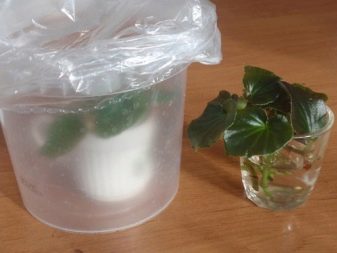
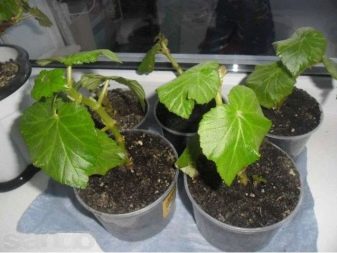
Advice! Begonia soil is sold in stores, but you can make it yourself. It is important that it has a light density, high fertility and is slightly acidic or neutral in composition.
Care
After new leaves began to appear on the shoots, the shelter must be removed. It is necessary to transplant the flower to a permanent site of residence. The ideal conditions for a young plant that reproduces are as follows.
- The container for a new flower does not have to be huge. For a start, a sufficient size is 710-810 millimeters. There should be holes at the bottom of the pot so that excess liquid can drain. It is better to use a ceramic pot than a metal one.
- The soil for this plant can be purchased at special flower shops. To independently prepare the soil, mix 2 parts of sod land and 1 part of leaf humus, sand and peat. To prevent the root system of the flower from rotting, a drainage layer must be laid at the bottom of the container.
- Begonia must be well provided with light. But the hot sun can burn the leaves of the flower. Therefore, in the summer, it is necessary to place the flower on the east or west windowsill.
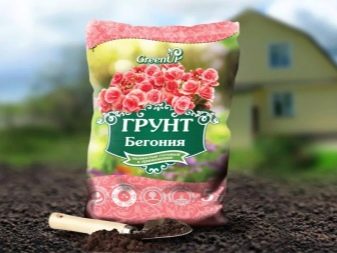

Temperature
The normal temperature for a plant is considered to be room temperature, about 21-26 degrees. In winter, the temperature is needed in the range of 16-19 degrees. This flower needs high humidity, but you should not spray the plant with water. Therefore, it is necessary to move the container onto the support in the tray with the liquid. Stones can serve as a stand.
The most important thing is that the bottom of the container should not come into contact with the liquid.
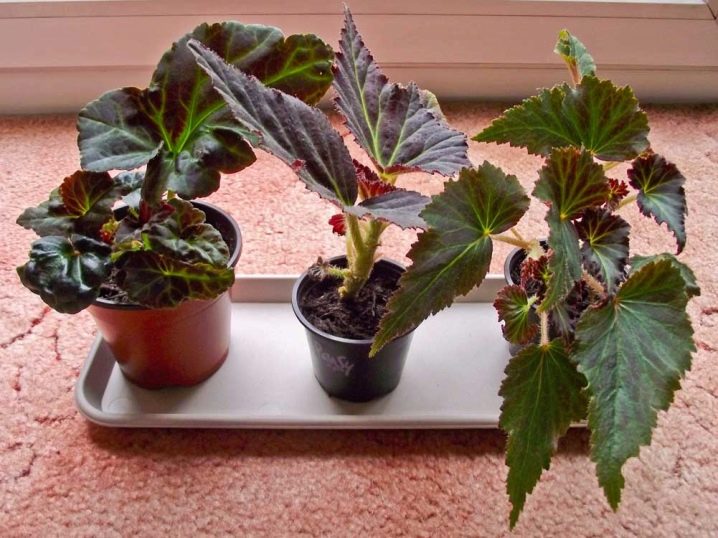
Watering
Water the plant abundantly, but do not spray on the stems and leaves. You can water the flower through the pallet; for this, the container must be placed in a container with liquid for 21-31 minutes. The irrigation liquid must be settled and have room temperature. In winter, watering should be reduced, and tuberous varieties should not be watered at all at this time of year.

Top dressing
When flowering begins, you need to use complex mineral fertilizers and add them to the plant before the end of the flowering time. Additional nitrogen fertilization for the flower is not used. But if the plant becomes weak and lethargic, then nitrogen fertilizers can be used.
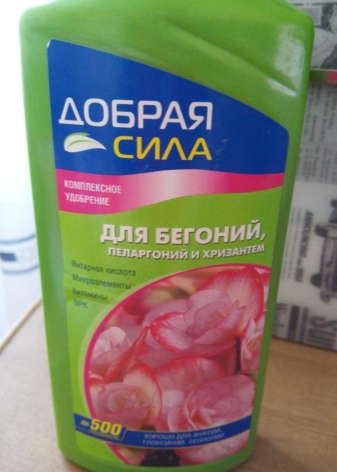
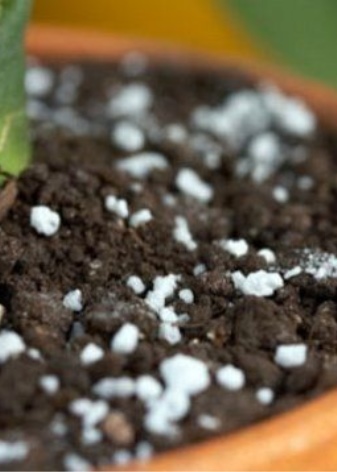
Transplant and pinching
When springtime comes, you need to transplant a flower into a wide pot. But if the root system has grown quickly, and the plant has become cramped, then the transplant can be done in another period. As soon as the flower has been transplanted, it must be placed after a while in a darkened room. Then you need to form a bush. It is necessary to pinch the main shoots so that additional ones are formed. Weak branches and faded buds must be removed.
It is important not to cut the plant too much so that it does not dry out at all.

What problems might arise?
When growing begonias by cuttings, some problems can arise.
If roots don't appear
For them to arise, the following rules must be observed. It is worth refreshing the cut on the handle, which is in the liquid, and pouring clean water. You can also add "Kornevin" to the liquid.It is necessary to check the dryness of the soil, if the ground is dry, then you need to cover the cutting to obtain high humidity. It is necessary to periodically change the option of soaking cuttings in liquid for the method of rooting cuttings in the soil. There is no rush, you need to give the flower time.
If small roots can appear in the liquid after 7-10 days, then in the soil they will grow only after 22-30 days.


If the flower does not develop
We need to inspect the plant. Due to poor care, diseases and pests can appear. Diseases can be cured with the help of special preparations, and harmful insects must be removed on their own or use systemic insecticides. It so happens that the flower is too filled with liquid. If the plant is lethargic, then you need to remove the soil from the pot so that it dries. It is necessary to replace the soil and prune rotten roots. Then you need to put the begonia back in the container.
If the flower does not develop with the onset of winter, then it must be left until the onset of spring. In the springtime, begonia will continue to develop. In the summer, the plant needs to be transplanted outside to make it healthier. It is important that the room where the begonia will be planted is protected from winds, showers and the hot sun. Thus, this flower is very easy to care for, it is easy to cut and grow. If the cuttings cannot take root, then you need to plant them again.
How to propagate begonia by cuttings, see below.































The comment was sent successfully.